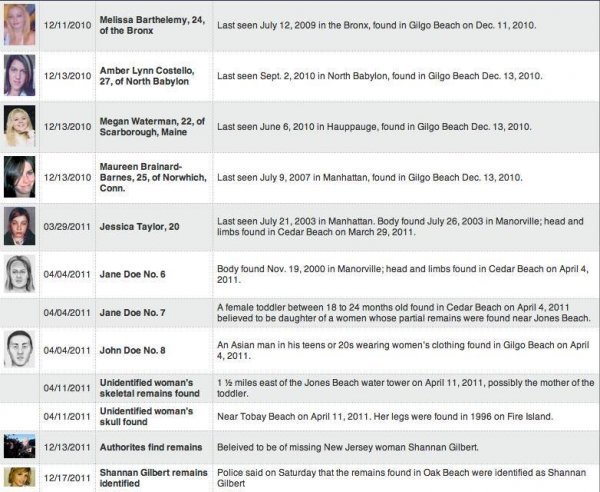In the summer of 2009, a 15-year-old Buffalo girl received disturbing phone calls from a man who taunted her about her missing older sister.

buffalonews.com
Mother of missing Buffalo woman helped kick-start investigation of serial killer of Gilgo Beach
Dan Herbeck ,
Lou Michel
Jul 23, 2023
In the summer of 2009, a 15-year-old Buffalo girl received disturbing phone calls from a man who taunted her about her missing older sister.
What made the calls especially scary was that the caller was using the cellphone owned by the missing woman, Melissa M. Barthelemy, 24.
At one point, according to police, the caller bragged that he had sexually assaulted Barthelemy and then killed her.
Today, those phone calls to Amanda Funderburg and other members of her Buffalo family are cited as important evidence in the murder case against accused serial killer Rex A. Heuermann, a Manhattan architect and Long Island resident.
Suffolk County police on July 13 charged the 59-year-old Heuermann with murdering Barthelemy and two other young women, all described in court papers as sex workers. Prosecutors also call Heuermann the “prime suspect” in the murder of a fourth female sex worker.
Heuermann denies the murder allegations.
The victims’ bodies were found buried in burlap cloth along Gilgo Beach on Long Island, not far from the suspect’s home. A massive investigation is continuing into the deaths of five other people found buried at Gilgo Beach, including those of a man, three women and a toddler.
Potentially, the serial killer case could go much further.
“Now that we have his DNA, we are checking with cities all over the country, to see if there could be any connection to other unsolved murders,” said State Police acting Superintendent Steven A. Nigrelli, whose investigators serve on a task force probing the murders and helped arrest Heuermann. “The task force is checking into unsolved killings in all the places where Heuermann traveled over the years.”
Barthelemy was a former Buffalo resident who was living in New York City when she disappeared in July 2009.
The taunting phone calls allegedly made by Heuermann to Barthelemy’s family in Buffalo in July and August of 2009 were mentioned several times in court papers filed by the Suffolk County District Attorney’s Office in connection with the arrest.
View attachment 19925
Rex Heuermann, a Long Island architect, has been charged with murder in the deaths of three of the 11 victims in a long-unsolved string of killings known as the Gilgo Beach murders including Western New York native Melissa Barthelemy, 24, who had been living in the Bronx.
Associated Press via Suffolk County Sheriff’s Office
The court document states that calls using Barthelemy’s cellphone were linked to cellphone towers in areas close to Heuermann’s Manhattan office and Long Island home.
The court papers allege that the suspected killer also used Barthelemy’s phone to check her voice messages on July 11 and July 12, 2009.
“On July 17, July 23, August 5, August 19, and August 26, 2009, the Barthelemy phone made taunting phone calls to Ms. Barthelemy’s family members, some of which resulted in a conversation between the caller, who was a male, and a relative of Melissa Barthelemy, in which the male caller admitted killing and sexually assaulting Ms. Barthelemy,” the court papers say.
Undersheriff remembers case
News reports on Heuermann’s arrest brought back memories for former Erie County Undersheriff Richard T. Donovan and his former administrative assistant, Marilynn Calhoun-Allen.
In interviews with The Buffalo News, they both recalled the anguished calls they received in 2009 from Lynn Barthelemy, the missing woman’s mother, after her daughter vanished.
Lynn Barthelemy was “extremely upset, very frustrated” and convinced that something terrible had happened to her daughter, but she said police agencies were skeptical because her daughter had worked as a prostitute, Donovan recalled.
“She told me she had called the New York City police and other police agencies and nobody would take her seriously. Nobody would even take a missing person’s report,” Calhoun-Allen said. “I told her, my boss was out to lunch, and that he’d call her when he got back. She said, ‘No, he won’t. Nobody calls me back.’ I told her, ‘He will.’ ”
Barthelemy’s mother was “crying and sobbing, and it really hurt me to hear that,” Calhoun-Allen said. “I’m a mom, too, and I could only try to imagine what she was going through.”
Attorney Steven M. Cohen, who represented the Barthelemy family, told The News in 2011 that New York City police had a policy at the time of not investigating missing persons for 10 days and that because Barthelemy worked as a “hooker,” detectives would not be assigned to the case.
That policy led a desperate Lynn Barthelemy to call the Erie County Sheriff’s Office, pleading for help.
Donovan remembers talking to Barthelemy’s mother and quickly realizing that her fears were genuine. “I was our liaison with NYPD and I had some friends in their Intelligence Unit,” the retired undersheriff said. “I called them, and to their credit, they took it very seriously, and immediately contacted the mother.”
The NYPD investigators were especially interested because the taunting calls had come from the phone of the missing woman, Donovan said.
He and Calhoun-Allen said they are proud to have played a small part in the early stages of an investigation that led to the capture of an alleged serial killer. Both said they have been following developments in the case over the past 14 years.
View attachment 19924
Authorities search the home of murder suspect Rex Heuermann on July 18 in Massapequa Park. Detectives investigating the long-unsolved slayings known as the Gilgo Beach killings have continued their searches, recently including a storage facility in the Long Island community of Amityville.
Associated Press
A break leads to arrest
According to Suffolk County Police Commissioner Rodney Harrison, a major break in the investigation occurred recently when a State Police investigator determined that Heuermann in 2010 owned a Chevrolet Avalanche truck like one that was spotted in a neighborhood where one of the sex workers had vanished.
That information about the truck put Heuermann onto the radar of the Gilgo Beach task force, and they began investigating the architect’s travels, computer searches and phone records, police said.
Heuermann is accused of burying victims along a remote beach on Long Island’s south shore. Prosecutors said Barthelemy’s body was the first one found, on Dec. 11, 2010, by a K-9 police officer conducting a training exercise with his dog.
Two days later, the remains of the three other women were unearthed. In the coming months, police would recover a total of nine bodies.
According to a court document filed by prosecutors, the four women, all of them petite in stature, were found in graves “similarly positioned, bound in a similar fashion by either belts or tape, with three of the victims found wrapped in a burlap-type material.”
The court document does not specify how the killer murdered the women, only referring to “homicidal violence.” Besides the phone calls, authorities say they have other evidence, including DNA, that connects Heuermann to the slayings.
Barthelemy’s family
Barthelemy’s parents spoke to The Buffalo News in 2011, shortly after their daughter’s remains were positively identified by police. At that time, they declined to go into detail about what was said on the phone to Barthelemy’s younger sister, except that it was “horrible.”
The family said Barthelemy had graduated in 2003 from South Park High School and, later, the Continental Beauty School. After working at a Buffalo haircut shop, she had moved to New York City with dreams of one day owning a beauty salon.
The family also said they were aware that in New York City, she worked as an exotic dancer. They speculated that it was to make money to pay rent and other living expenses.
After she disappeared, the family said, her younger sister informed them that Barthelemy had confided to her that she had become an escort.
Her family told The News in 2011 that their last contact with her was in a text sent to her teenage sister late on the night of July 9, 2009.
Barthelemy was last seen alive the next day, prosecutors said.
The family has said little publicly since the arrest, except for a few comments to media outlets in the New York City area after the arrest of the alleged serial killer.
Amanda Funderburg, the younger sister, said the mystery caller using her sister’s phone belittled and disparaged Barthelemy for her line of work and suggested that he might someday tell her where her sister was.
“He killed Melissa after having sex with her,”
Amanda Funderburg told PIX11-TV in New York City after Heuermann’s arrest. “In the final call, he said he’d killed her.”
Barthelemy’s mother told NBC News reporters in New York City that
she wants Heuermann to suffer in prison.
“I’d like him to suffer at the hands of other inmates. Let him receive what the girls received,” Lynn Barthelemy said.
“We knew all along that the phone calls were going to be key,” the mother added, referring to the taunting calls police have linked to Heuermann.
While declining to give interviews this week to The News, Barthelemy’s family issued a statement on Thursday through Cohen.
They expressed gratitude to law enforcement for continuing to pursue the investigation that resulted in the arrest. They said they hope police got the right man.
“The Barthelemy family has held strong for all these years and they are hopeful that the killer has truly been captured,” the family said.
Nigrelli, a Buffalo native, and Donovan, the retired undersheriff, said they hope the arrest brings some kind of closure to a family that has suffered for 14 years.
“Their information was important to the investigation,” Donovan said. “I was very thankful when I heard of the arrest. Anytime you take someone like that off the street, it’s a good feeling. Criminals who do things like that, they don’t stop.”


 www.crimewatchers.net
www.crimewatchers.net


